The simple fact of the matter is that if a gun is good for shooting deer it is sufficient for shooting people. Seizing upon this obvious fact, arms designers have largely refrained from scrupulously dividing "sporting arms" and "military arms" into two independent, parallel lines of development. Advances in military arms are rapidly passed on to sporting arms and vice versa. Indeed, military arms are frequently pressed into service as sporting pieces after suitable modification and, more than one might think, the opposite occurs as well.
Thus, the majority of American centerfire sporting rifles currently produced are based either upon the AR-15 action or upon the Mauser action, both of which were originally conceived as infantry weapons. Even the quintessential non-military deer rifle, the Winchester Model 94, which was originally designed as a deer rifle, has been impressed into irregular military service on a number of occasions. If you can drop large ungulates with it, you can also kill large primates with it.
Thus, I'm all for the inclusion of "military" features into sporting rifles, especially when it makes my life easier. The Elmer Fudds of the world may object upon aesthetic grounds, but it needs to be realized that this sort of thing has been going on for ages. There's nothing "unsporting" about this either. What constitutes a fair hunt is a matter of staying within responsible limits of game harvest and personal, spiritual matters of what constitutes a satisfying hunt. I also support slapping people who decry the "unsporting" nature of this or that method of hunting when they themselves have never been hunting. Anyone ignorant upon a subject should refrain from pontificating upon it.
Now, with that out of the way, let's take a close look at the CX4 Storm, particularly with a view towards "military" features on a "sporting" rifle.

Now, anyone with a half-informed opinion of early 21st firearm aesthetics could tell you that is a "military" or even "futuristic" looking rifle. Someone three-quarters informed would point out the lack of a threaded muzzle or muzzle device of any sort. Someone fully informed would, of course, know that the rifle was initially marketed during the waning days of the odious 1994 Assault Weapons Ban, a singularly stupid piece of legislation based upon the silly, nonexistant distinctions previously mocked, which had the effect of losing the Democrats control of Congress and banning the new manufacture of guns that were about 1% of those used in violent crime. Due to the drastic, and still mysterious fall in violent crime during the early nineties, which only slightly predates the ban, many people actually believe that the law accomplished shit. Despite the exasperating idiocy of this trivially falsifiable view, one must be patient with such people. Many are otherwise intelligent and can be gently corrected. The rest... well, as the Cardigans put it, "Reason will not pledge a solution."
One can, of course only determine so much about a rifle by looking at the exterior and bitching about the excesses of the Clinton years, so let's break this baby apart:
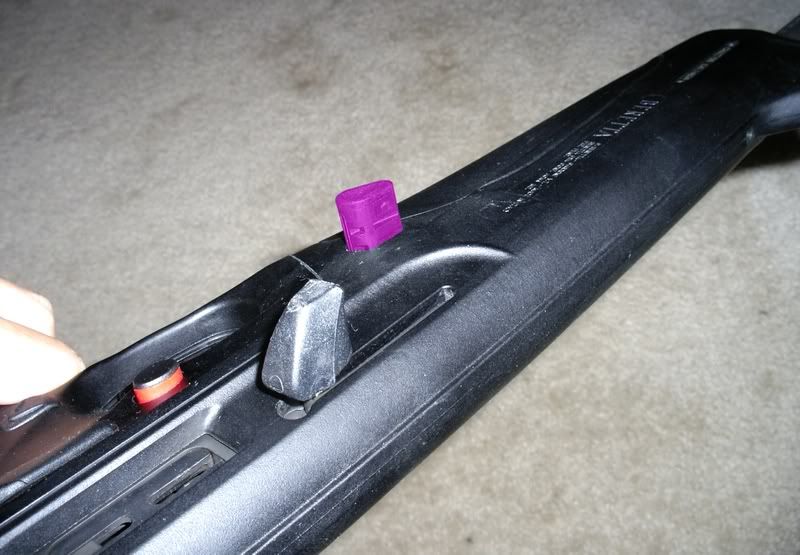
Once the rifle is cleared of ammunition, this is effected by pushing out a single, spring clipped polymer cross-pin highlighted here in Tactical Pink. This pin may be pushed out either to the left or to the right and re-inserted from either side. 4'7" tall career masseuses will find that their tiny steel fingers can work the pin out easily, but the rest of us hominids may elect to use a tool to accomplish this. Note that the pin actually comes all the way out, it is not captive like the takedown pins in the AR-15, so don't loose it!
This is the first "military" feature of the storm; it can be field stripped for inspection or cleaning without any specialized tools; indeed, if one is sufficiently dexterous, no tools whatsoever. I am of the opinion that all guns, and ideally all common household objects that require cleaning should be designed in this manner. As "military" in this case means "dead convenient" I must advocate the militarization of all things, because this feature is simply fantastic.
Since I can't think of a better place to mention it, I am not aware of any military on Earth that actually uses the gun. Closest I've ever heard is the New York State Highway Patrol, so anyone who describes this as a "paramilitary firearm" evidently considers speed cops to be paramilitary or is fond of sensational adjectives.
Once the cross-pin is removed, grab the forend of the gun with one hand and the stock with the other. Pull these apart from each other. The upper and lower receiver sections will separate thus:

The takedown pin is in Tactical Pink, while the upper receiver is in Calming Lime Green and the lower is in Arid Plum.
Separating into an upper and lower half is a trick borrowed ultimately from the Belgian FAL service rifle. Splitting the receiver in this manner allows greater access to the parts during, while still providing a rigid receiver suitable for optics mounting.
As in the AR-15, the lower receiver houses the trigger, safety, magazine catch, bolt catch and hammer mechanisms. These collect relatively little fouling during firing and thus their cleaning regimen can be light. They are also
To begin disassembly of the upper, pull the charging handle all the way back until it sits in the circular cutout. Pull it outwards, away from the receiver to remove the charging handle from the bolt as so:
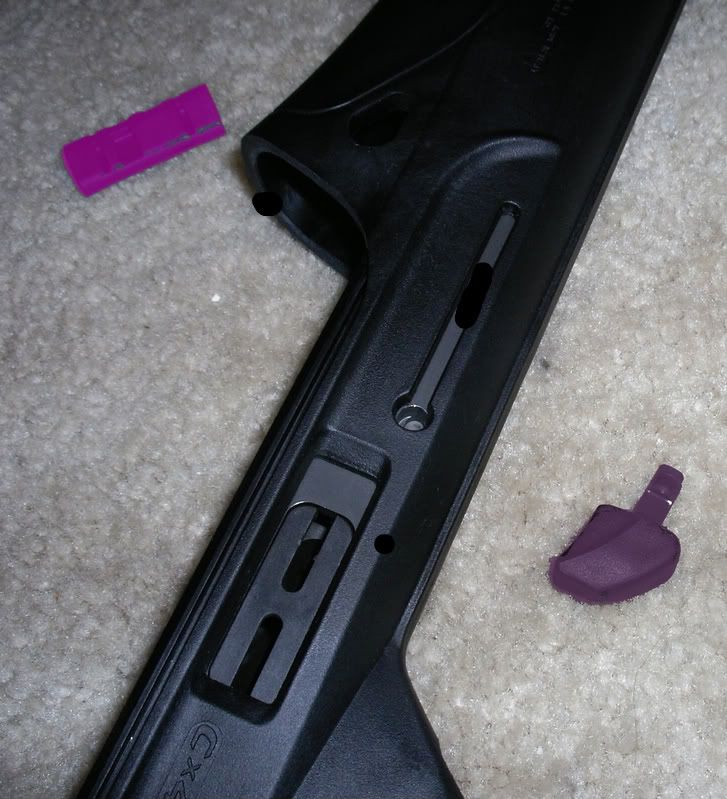
takedown pin in Tactical Pink and charging handle in Dynamic Taupe
It is perhaps worth noting that this method of bolt and charging handle retention is very similar to that in the AR-18. While I prefer to have a reciprocating charging handle permanently attached to the bolt, as it means one less thing I can loose, the mirror-image cutout holes on either side of the bolt which allow the charging handle to be installed upon either side and thereby accommodate left and right handed shooters arguably justifies this choice.
With the charging handle removed, the bolt may be taken out of the receiver by pulling on it directly, or upending the muzzle away from the local gravitational vector and allowing the bolt to fall out:
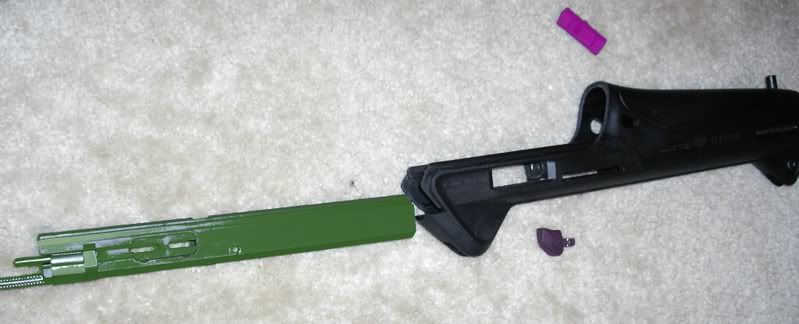
bolt in Assault Myrtle
Two things about the bolt are worthy of note;
1) It's a heavy cast iron son of a bitch, probably accounting for around a third of the weight of the gun. This is because the only thing keeping the breech of the gun sealed during the balmy peak firing pressure of 28,000 PSI is the inertia of that bolt. There is no mechanical locking, not even a retardation or delay mechanism. Be glad it's that heavy.
2) The bolt "wraps around" the barrel, which is to say that most of the weight of the bolt lies substantially in front of the pistol grip. This "telescoped" bolt design was first developed in Czechoslovakia just prior to WWII, but only became popular in after the uzi submachine gun became a certified triple platinum hit with lots of cheap imitators. It allows a shorter receiver and for the magazine to be placed in the grip by moving all the requisite mass and bulk of the bolt forwards, although in the CX4 Storm it is arguably unnecessary as the bolt could easily have tucked into the stock.
Look at the rear of the bolt. On top is a small, thin metal cover here slightly brightened and highlighted in Combat Puce:
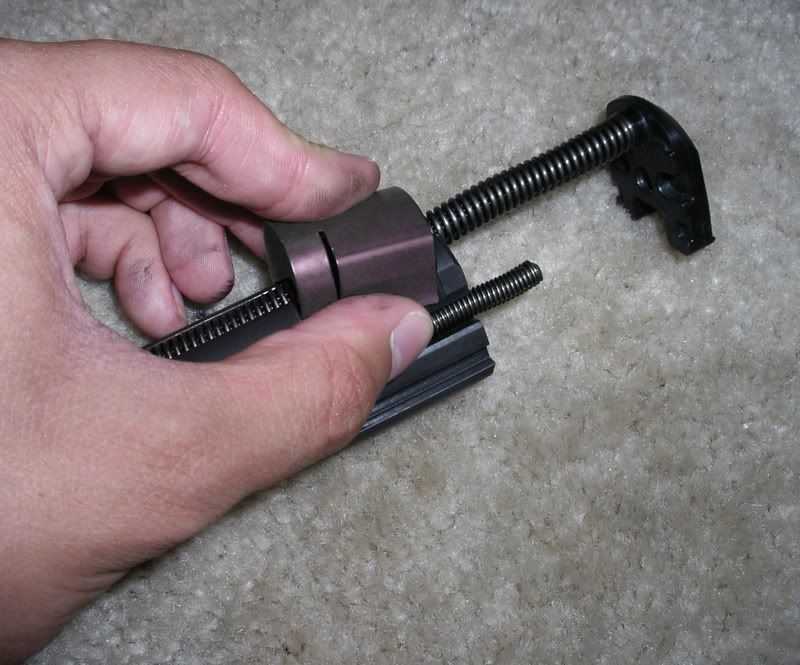
Remove this by pulling it upwards. You may now remove the return spring (large spring doohickey in the photo), ejector (small spring doohickey in the photo), cage (small slotted plastic doohickey) and extractor (small, not spring-loaded doohickey not seen in photo, opposite the ejector).
Here are the ejector and extractor:
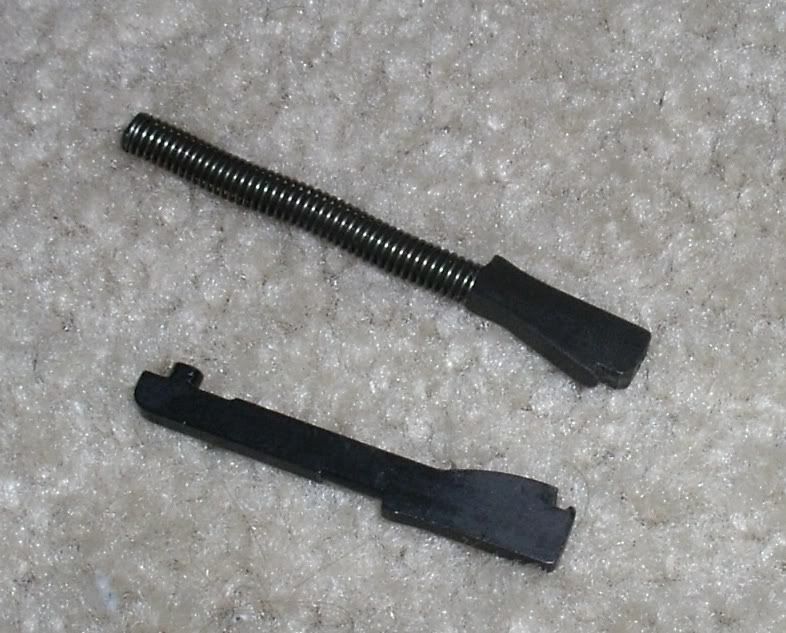
The ejector is the one on top.
Notice how similarly shaped they are? They fit in mirror-image slots on the margins of the bolt face and may be reversed to reverse the direction of ejection to help better accommodate left-handed shooters. Make sure to install the cage on the opposite side from the extractor and on the same side as the ejector:
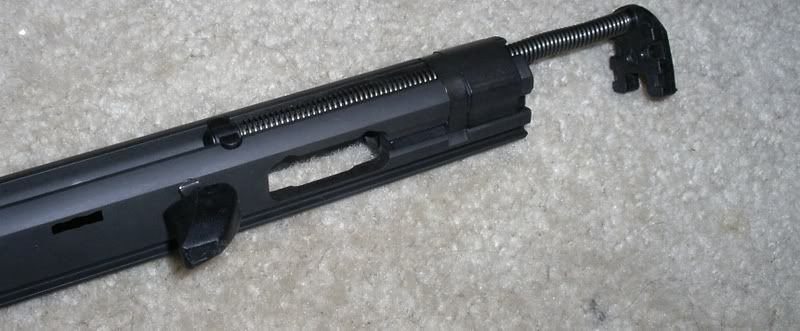
To re-install the bolt, take out the charging handle before lining the bolt up with the charging handle hole:
Then replace the lower receiver and takedown pin and the gun is re-assembled.
The CX4 storm is joyously simple, and despite its "futuristic" appearance there is absolutely nothing fancy going on under the hood. The gun operates on the simple principle of blowback; that is, the unlocked bolt is blown back by the force of the cartridge being fired and returned forwards by the return spring. Not only is straight blowback simpler than all other semi-automatic operation cycles, it's actually simpler than manually-operated operation cycles as well, as those require some sort of locking mechanism.
Still, the internals have some way to go before they could be considered to be artistically simple. Unfortunately, the BATFE has arbitrarily ruled that open-bolt operation constitutes an NFA-controlled, post-86 machinegun (it shouldn't, but they are idiots), so there is no possibility of eliminating the articulated firing mechanism entirely and using Advanced Primer Ignition with a fixed firing pin, as do the majority of military submachineguns. A simplified, tooless removable hammer and trigger group would not go unappreciated, however. A glock-style safety trigger, perhaps, with the sear surfaces on the bolt and striker, rather than hammer firing, might reduce parts count. Eliminating the crossbolt safety and improving the trigger pull would do a lot to induce warm and fuzzy feelings in me. It is also unclear to me why there aren't mirror image bolt catches, as this is the one piece that's actually a bitch to move around for left to right conversion, and one of the most important.
And there's a (to me) obvious way to improve the arrangement of the swappable extractor and ejector, but in the interest of opsec on up and coming designs from other companies, I'll let you figure that out for yourself.